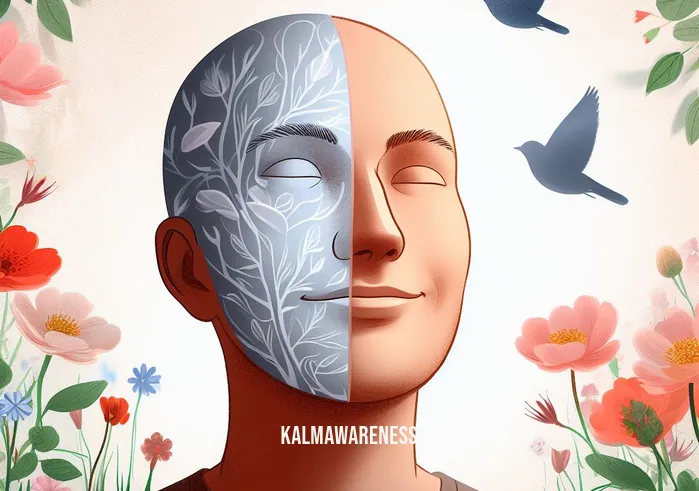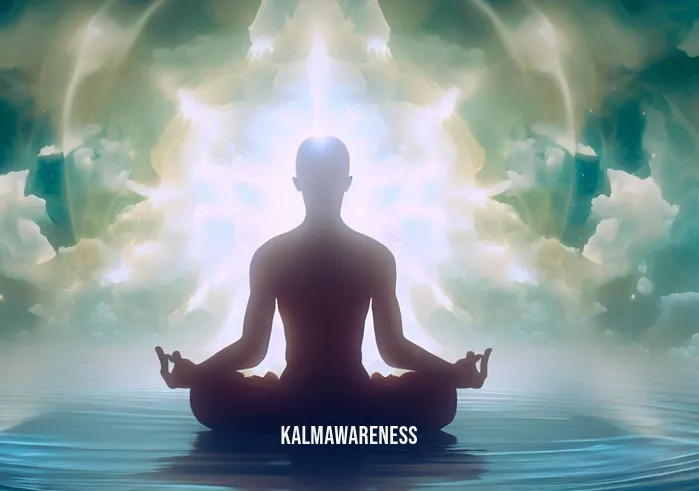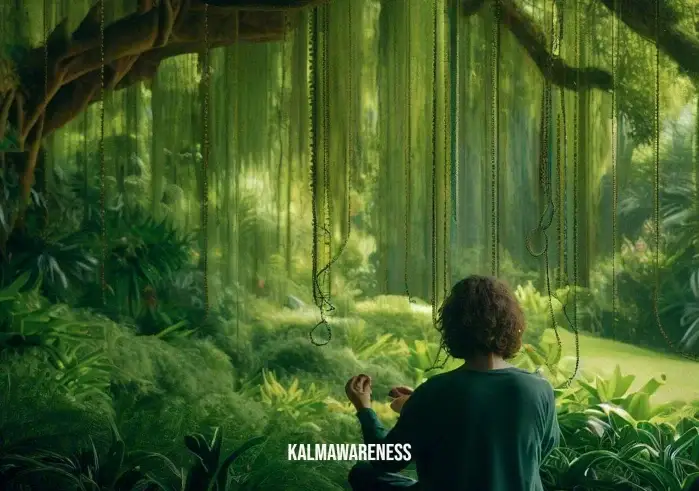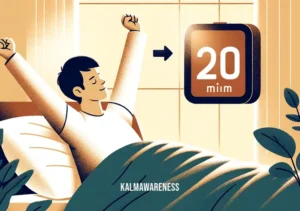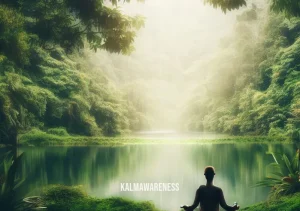Meditation to End the Day: The Ultimate Evening Ritual for Peace
As the sun sets and the world prepares to embrace the night, it’s imperative to take a few moments to release the day’s stress and recalibrate. A dedicated practice of meditation to end the day can be a transformative approach to unwind and set the stage for rejuvenating sleep. In this article, we’ll explore the benefits of such a ritual and offer guidance on making it a lasting habit.
The Need for Evening Meditation
You might’ve heard about the importance of starting your day with a focused mindset, but what about ending it? The brain undergoes a barrage of information, emotions, and thoughts throughout the day. It’s easy to carry that mental clutter into our nights, leading to disrupted sleep or unwelcome dreams.
“Life is available only in the present moment.”
An age-old sentiment that reminds us of the importance of being present, especially as we wind down for the day.
Ancient Roots and Modern Approaches
Meditation, in its many forms, has been practiced for millennia. There’s a vast reservoir of knowledge to tap into, from ancient African meditation techniques to modern methods like micromeditating. The underlying principle remains consistent – to cultivate mindfulness and awareness.
Micromeditating: A Glimpse
Micromeditating offers a way to integrate meditation into our bustling lives seamlessly. It’s about stealing small moments – even just a minute or two – and grounding oneself. For those who find it challenging to carve out longer periods, this approach is especially appealing.
Mindful Muscle and Physical Activity
Meditation doesn’t always mean sitting in a quiet corner with closed eyes. Activities like mindful martial arts or mindful hiking can be incredibly grounding. Building our mindful muscle enables us to approach activities with full presence, turning them into meditation in motion.
Benefits of Evening Meditation
- Promotes Better Sleep: Transitioning from a state of mindfulness often results in deeper, more restorative sleep.
- Relieves Stress: Meditating helps to shed the accumulated stress of the day.
- Aids in Emotional Regulation: Helps to process emotions and cultivate a balanced mindset.
- Builds a Habit of Mindfulness: Regular practice reinforces mindfulness, which can be carried into other areas of life, like habitual thinking.
“Meditation in motion is a way of life, not just a practice.”
Meditation in motion emphasizes the seamless blend of mindfulness into everyday actions. By adopting such practices in the evening, the transition from wakefulness to rest becomes smoother.
Incorporating Meditation into Your Evening Routine
Setting aside time for evening meditation requires commitment. Begin with these steps:
- Designate a Calm Space: Choose a quiet, comfortable spot in your home. This could be a dedicated meditation corner or a cozy nook.
- Choose a Method: Decide between static meditation, meditation in motion, or a mix. There are countless resources, from books for teens to classes like the Penn mindfulness class to help you navigate.
- Stay Consistent: Whether you opt for a minute of micromeditating or a longer session, consistency is key.
- Seek Guidance: If you’re new to the practice, consider seeking a meditation consultant to guide you through the initial stages.
Remember, the objective isn’t to “achieve” something but to experience the present. The journey is the reward.
Invite you to continue to the next part of this article, where we’ll delve deeper into specific meditation techniques suitable for evenings and how to overcome common challenges. We’ll also explore the enriching world of mindful miracles and their place in a serene night’s practice.

Meditation Techniques for a Serene Night
While establishing the concept of meditation to end the day in the prior chapter, this section delves into specific techniques tailored for evening sessions. These techniques aren’t just methods; they’re doorways into realms of deep relaxation, paving the way for a night of restful sleep and rejuvenation. Additionally, for those keen on diving into related areas, a table detailing the different forms of evening meditation, their origins, and benefits will be explored.
Popular Evening Meditation Techniques
Guided Imagery: This involves listening to a guide (either in person or via a recording) that takes you on a mental journey to a serene location. The soothing narrative aids in letting go of stress and embracing tranquility. For instance, gratitude yoga practices in Princeton sometimes incorporate guided imagery to deepen relaxation.
Body Scan: A systematic mental scan of one’s body, from head to toe, noting sensations without judgment. This method aligns closely with the concept of mindfulness taught in courses, cultivating a deeper connection with oneself.
Deep Breathing: While there are various breathing techniques, the essence is to focus on one’s breath, drawing in deep, slow breaths, holding momentarily, and then releasing. This process can be likened to micromeditating, where even a few minutes can induce calm.
Mantra Repetition: Repeating a phrase or word, like “peace” or “relax”, can anchor the mind and prevent it from wandering. Such mantras can even be borrowed from other cultures, expanding one’s understanding just like how you would when exploring mindfulness in Spanish.
Progressive Muscle Relaxation (PMR): This involves tensing and then relaxing different muscle groups in the body. For those keen on merging mindfulness with physical activity, this can be a step further after engaging in practices like mindful martial arts.
Table: Forms of Evening Meditation and Their Details
| Type of Meditation | Origin | Key Benefits |
|---|---|---|
| Guided Imagery | Western Psychotherapy | Reduces stress, Enhances visualization skills |
| Body Scan | Traditional Buddhist practices | Increases body awareness, Relieves physical tension |
| Deep Breathing | Global; Pranayama in Indian Yogic tradition | Reduces anxiety, Enhances focus |
| Mantra Repetition | Vedic tradition from India | Improves concentration, Infuses positivity |
| PMR | Modern Western therapy | Alleviates muscle tension, Promotes body-mind relaxation |
Tailoring Techniques to Personal Needs
It’s important to remember that meditation is deeply personal. While the aforementioned techniques are proven, they aren’t one-size-fits-all. For instance, if you’re someone who’s going through a significant life change like menopause, you might find resources on meditation specifically tailored for menopause more suited to your needs.
Similarly, if you’re a student overwhelmed with the pressures of academia, narratives like meditation stories for students can offer solace and guidance.
Ultimately, the right technique is the one that resonates with you, aligning with your evening energy and bringing you to a space of calm and clarity.
Invite you to continue to the next part of this article, where we’ll explore the challenges people often face while establishing a meditation routine and how to overcome them. Alongside, we’ll look into resources, such as the vast array of mindfulness books available, to deepen one’s understanding and enhance the practice.
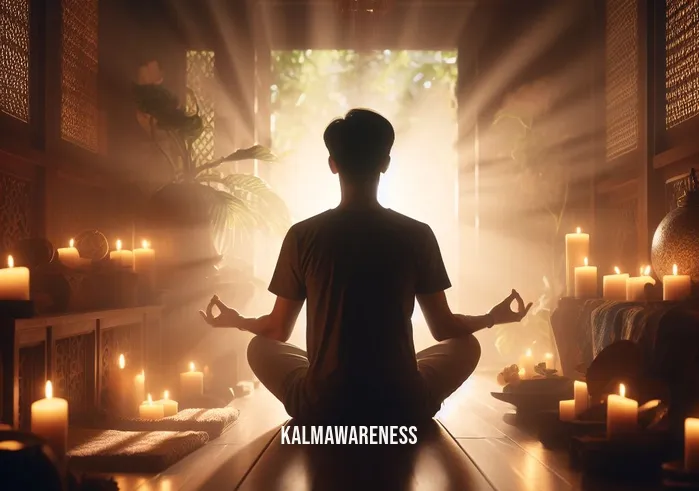
Overcoming Obstacles in Your Meditation Journey
Embarking on the path of meditation to end the day can be akin to navigating uncharted waters. While the tranquility that ensues is unparalleled, the initial steps may seem daunting. Challenges arise, but they’re not insurmountable. This chapter provides insights into common obstacles meditators face, solutions to overcome them, and inspiring quotes to light the way.
Facing and Embracing Challenges
1. Lack of Time
“I have so much to do that I shall spend the first three hours in meditation.” – Martin Luther.
While this might sound counterintuitive, sometimes the more occupied we are, the more we need meditation. But how does one find the time, especially when the day feels rushed? The solution lies in understanding that meditation doesn’t need to be lengthy. Micromeditating, as previously mentioned, offers quick sessions that can seamlessly integrate into tight schedules.
2. Struggling with Focus
“What you focus on grows, what you think about expands, and what you dwell upon determines your destiny.” – Robin Sharma.
Our modern world constantly vies for our attention. Bringing the mind to a standstill, or even to a slow crawl, seems impossible. Yet, remember that meditation isn’t about halting thoughts but observing them. Techniques like mindful skills can aid in enhancing focus gradually.
3. Feeling Disconnected
“In today’s rush, we all think too much — seek too much — want too much — and forget about the joy of just being.” – Eckhart Tolle.
Feeling disconnected, both from oneself and the surroundings, is a common challenge. Grounding practices, like taking mindful walks in nature or engaging in mindful hiking, can forge that lost connection. The essence is to be present, absorbing the sights, sounds, and sensations fully.
4. Expecting Quick Results
“Do not dwell in the past, do not dream of the future, concentrate the mind on the present moment.” – Buddha.
Meditation is a practice, not a destination. Expecting immediate transformation might lead to disappointment. Instead, approaching it with patience and relishing the journey is crucial. If guidance is what you seek, resources like the a renewed mind employee portal might offer the structured approach you crave.
5. Physical Discomfort
“The body benefits from movement, and the mind benefits from stillness.” – Sakyong Mipham.
Sitting still for extended periods can lead to physical discomfort. Fortunately, not all meditation requires stillness. Dynamic practices, like mindful martial arts, blend movement with mindfulness, offering both physical activity and mental tranquility.
Drawing Inspiration from Legends
Inspiring quotes from esteemed personalities can be a beacon of hope. Here are a few that resonate deeply with our theme:
- “Peace comes from within. Do not seek it without.” – Buddha.
- “The thing about meditation is that you become more and more YOU.” – David Lynch.
- “Meditation is the soul’s perspective glass.” – Owen Feltham.
- “To a mind that is still, the whole universe surrenders.” – Chuang Tzu.
- “Meditation is not to escape from society but to come back to ourselves and see what is going on.” – Thich Nhat Hanh.
It’s essential to remember that every individual’s meditation journey is unique. What works for one might not for another. Yet, the underlying thread that ties every meditator is the pursuit of inner peace and a balanced life. As you practice meditation to end the day, you’re gifting yourself a sliver of tranquility in a chaotic world.
Invite you to continue to the next part of this article, where we’ll discuss creating a conducive environment for meditation. From setting up the perfect meditation space to incorporating calming elements, we’ll dive deep into crafting a sanctuary for your evening ritual. The journey will be accompanied by insights from mindful miracle practices to infuse your sessions with added serenity.
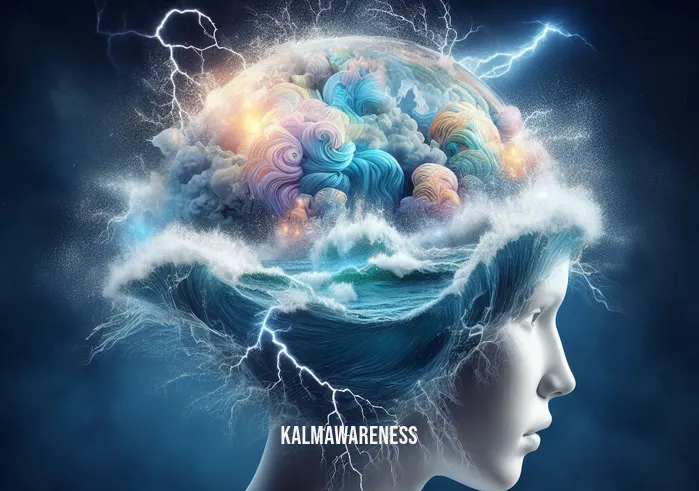
Crafting the Ideal Meditation Environment
An essential aspect of meditation to end the day is setting up the right environment. Just as a seasoned chef requires a well-organized kitchen, a dedicated meditator benefits from a space that exudes serenity and focuses on the practice. By the end of this chapter, you’ll have a comprehensive understanding of creating that sanctuary. Let’s break down the essentials:
1. Selecting the Right Spot
- Ambiance: A calm, quiet corner of your home, free from regular foot traffic.
- View: If possible, face a garden, a simple wall, or a serene painting. The mindful miracle practices often emphasize the importance of minimal distractions.
- Space: Enough room to sit comfortably and move around a bit, especially if you’re into meditation in motion.
2. A Comfortable Seating Arrangement
- Cushion or Chair: Depending on your preference and physical health.
- Mat: If you prefer sitting on the ground, a soft mat or a meditation pleine conscience inspired setup could be beneficial.
- Alignment: Ensure your back is straight, promoting an unobstructed flow of energy.
3. Calming Sensory Inputs
- Sight: Soft, warm lights or candles can create a calming effect. Maybe even a piece of mindful artwork like the ones mentioned in mindful en espanol.
- Sound: Consider playing soft, meditative tunes or nature sounds. Alternatively, the quiet can be just as profound.
- Smell: Incense or essential oils with scents like lavender or sandalwood can greatly enhance the relaxation process.
4. Eliminating Distractions
- Digital Devices: The distance from phones, tablets, or computers. These devices, with their notifications, can disrupt the flow of your meditation.
- Time: Set a designated time for your meditation, perhaps after reading some mindfulness books for teens, or another calming activity. Knowing there’s a set duration can ease the mind.
5. Personal Touches
- Sacred Objects: Introducing items that have personal significance can boost the meditative experience, making the space feel truly yours.
- Inspiring Reads: Having a book on ancient African meditation techniques or any other inspirational material can be beneficial. It serves as a source of learning and an enhancement of the practice.
6. Keeping It Clean and Tidy
- Simplicity: A clutter-free environment translates to a clutter-free mind. Regularly cleaning and maintaining your space is crucial.
- Arrangement: Everything should have its place. After every session, return items like cushions, mats, or books to their designated spots. This ritual can be as meditative as the practice itself.
7. Dedication
It’s worth mentioning the value of dedication. Once you’ve set up your space:
- Consistency: Aim to meditate there daily. Over time, just entering this space will automatically instill a sense of calm.
- Respect: Treat this space as sacred. Just as one would not tarnish a temple, keep this area exclusively for meditation and avoid bringing in stress or negative energies.
Meditation to end the day is about more than just the act. It’s a holistic experience, and the environment plays a pivotal role in that. Taking the time to craft a conducive meditation space can significantly enhance your daily practice. It not only sets the tone for the meditation but also symbolizes your commitment to self-care and inner peace.
Invite you to continue to the next part of this article, where we will explore the various meditation techniques one can incorporate to wind down the day. From the tranquility of life available only in the present moment to the power of deep breathing practices, the upcoming section promises a plethora of insights.
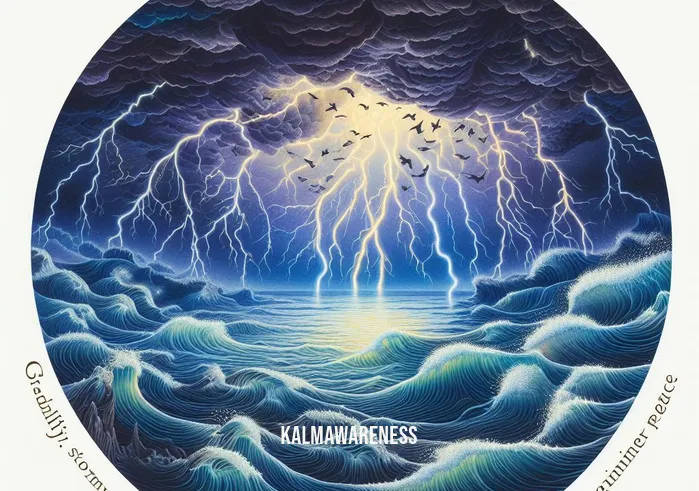
The Art of Culmination: Finding Your Unique Evening Meditation Mantra
The practice of meditation to end the day is as diverse as the people who partake in it. You might have established an ambiance, learned various techniques, and even incorporated insights from the masters. Yet, the final touch to your meditation is deeply personal. It’s a mantra, a sentiment, a small ritual that seals the meditative process and ushers in peaceful slumber.
Finding Your Personal Mantra
While traditional mantras resonate with many, crafting a personal mantra taps into a profound corner of your soul. Here’s how:
Reflection: Think about your day – your achievements, the challenges you faced, and the feelings you navigated. Allow these to guide your mantra. For instance, after a day spent strengthening your mindful muscle, your mantra might be a silent acknowledgment of your inner growth.
Positivity: Channel the essence of hopeful writings, much like the uplifting insights in mindful hiking. Your mantra could be as simple as “With every step today, I moved towards peace.”
Consistency: A mantra’s power intensifies with repetition. Over time, your evening mantra becomes a conditioned cue for your body and mind to relax and prepare for rest.
Incorporating Gentle Movements
There’s an exquisite interplay between meditation and motion, often underscored in practices like mindful martial arts. A few stretches or yoga postures before settling down for meditation can be an effective ritual to signal the body it’s time to wind down.
Savoring a Sip of Serenity
Embrace the quiet moment post-meditation with a soothing beverage. This act of mindfulness, reminiscent of the consciousness you bring to micromeditating, can act as a bridge between your meditative state and the world of dreams.
Journaling: The Window to Inner Clarity
End your meditation with a brief journaling session. Pen down your reflections, the sensations you felt, or even a future intention. Not only is this an extension of your mindfulness practice, reminiscent of sessions like those from penn mindfulness class, but it also aids in tracking your progress and growth.
Closing Rituals
Beyond all these, there are small rituals that might resonate with you:
- Lighting a specific incense after meditation, a scent that tells your senses that it’s time to rest.
- Listening to a particular song or sound, maybe something you discovered during your exploration of habitual thinking definition and its influence on our psyche.
- Saying a prayer or expressing gratitude, akin to the principles you’d find in gratitude yoga princeton.
As you close your evening meditation chapter daily, remember, there’s no rigid path to serenity. It’s the small touches, the personal flairs, the unique rituals that mold your meditation to end the day into an experience that’s intrinsically yours.
Thank you for joining us on this journey of enlightenment and relaxation. Our hope is that these insights equip you with the tools and understanding to cultivate a meaningful end-of-day meditation routine. And as the curtain draws on this exploration, we invite you, dear reader, to delve deeper into the myriad topics on our site. From understanding the role of a meditation consultant to honing mindful skills, there’s a vast expanse of knowledge awaiting your curiosity.
Here’s wishing you success, peace, and countless serene evenings ahead. Remember, each day’s end is but a prelude to a fresh beginning. Stay inspired, stay mindful, and we look forward to welcoming you back for more insights in our magazines.
